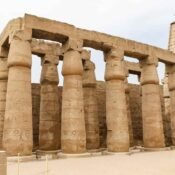
Karnak Temple in Luxor
Have you ever visited Karnak Temple in Luxor? In this blog post, we’ll explore the history of Karnak Temple and how its sound and light show is bringing it to life.
History of Karnak Temple
Karnak Temple is one of the most remarkable historical sites in Luxor, Egypt. It was built in 3000 BC, and was the main place of worship for the Ancient Egyptians. The temple was dedicated to Amun, the chief god of Thebes, and it was part of a larger complex that included a palace, an observatory, and a mortuary temple.
Over time, many additions were made to the complex, including the construction of an avenue of sphinxes that lined the entrance to the temple. In total, the temple complex covers an area of about 200 acres and contains numerous monuments and buildings.
Light and Shadow Effects Within the Temple
The Temple of Karnak is a perfect example of the ancient Egyptian art of using light and shadow to create unique optical effects. The temple complex is filled with various monuments that are illuminated at night, providing a captivating view to visitors. The most prominent example of this is the façade of the Great Hypostyle Hall, which has 32 columns each topped with a bud-shaped capital. On special occasions, these columns are lit up with spotlights that create an incredible display of light and shadow. The effect is heightened by the fact that the walls of the temple are made from limestone, which reflects the light to create an even more vivid display. Furthermore, the presence of obelisks in the temple further enhances the play of light and shadow that occurs.
Sound in the Temple and its Acoustical Properties
The Sound and Light Show at Karnak Temple in Luxor is a unique experience that combines the mesmerizing effects of light and sound with the ancient history of the temple. But there is also a deeper connection between sound and the Temple of Karnak.
Acoustical properties of the temple were carefully studied by ancient priests and used to create a connection between man and the gods. The acoustical properties of the temple were so impressive that it was said that conversations could be heard from one end of the temple to the other. Music and chanting within the temple was also used to create a spiritual atmosphere, as well as to honor and praise the gods.
The Role of the Priests at Karnak Temple
The priests at Karnak Temple played a significant role in the history of this ancient building. While the Pharaohs were the ones who built, designed and maintained the temple, the priests were in charge of conducting rituals and ceremonies that were connected to the gods. The priests also acted as advisors to the Pharaohs, helping them to make decisions about the temple. They were also involved in writing and reading hieroglyphics, which helped to communicate messages between the Pharaohs and the gods. The priests at Karnak Temple were highly respected and held a great deal of power within the society.
The Role of Hieroglyphics in Karnak Temple
The impressive hieroglyphic carvings in the Temple of Karnak are one of the most fascinating aspects of its architecture. These hieroglyphics tell stories of the gods and goddesses, as well as the history of the people that lived in Luxor. The walls of Karnak Temple are filled with these ancient symbols, and visitors can explore them to get a glimpse into the past. They can also observe the inscriptions written in hieroglyphics, which are believed to have been used to communicate with the gods. Not only do these hieroglyphics offer a glimpse into the past, but they also serve as a reminder of the importance of language and communication.
Recent Posts
Luxor day tour: Most Illuminated Temples
Discover Luxury Nile Cruises
Designing the Perfect Itinerary for Your Nile Cruise




